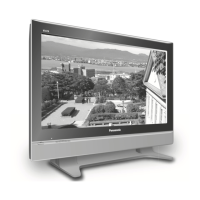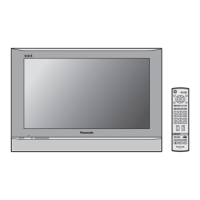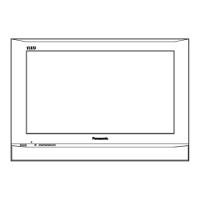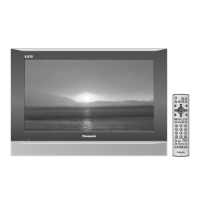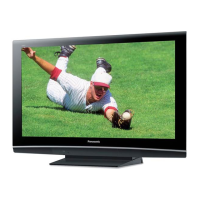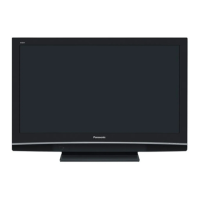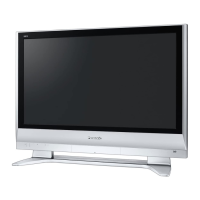Why does my Panasonic Plasma TV have no colour?
- QqcruzSep 12, 2025
If your Panasonic Plasma TV has no colour, check that the colour controls are not set to minimum levels.
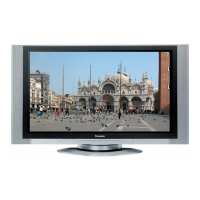
Why does my Panasonic Plasma TV have no colour?
If your Panasonic Plasma TV has no colour, check that the colour controls are not set to minimum levels.
What to do if sound reception deteriorated on Panasonic Plasma TV?
If the sound reception on your Panasonic Plasma TV has deteriorated, switch the MPX setting (in the Sound menu) to Off until reception improves.
Why some parts of the screen do not light up on my Panasonic TH-42PA20 Plasma TV?
The plasma TV panel is manufactured using an extremely high level of precision technology; however, sometimes some parts of the screen may be missing picture elements or have luminous spots. This is not a malfunction.
| Depth | 658 mm |
|---|---|
| Width | 1170 mm |
| Height | 99 mm |
| Weight | 35000 g |
| I/O ports | Composite Video Input S-Video Input PC Input (Mini D-sub 15-pin) Monitor Output Headphone Jack Serial (RS232C) |
| Pixel pitch | 1.08 mm |
| Product color | Silver |
| RMS rated power | 16 W |
| Display diagonal | 42 \ |
| Sound output mode | stereo |
| Display resolution | 852 x 480 pixels |
| Display technology | Plasma |
| Power requirements | AC 220 - 240 V, 50/60Hz |
| Contrast ratio (typical) | 4000:1 |
| Power consumption (typical) | 313 W |
Covers fire, shock hazards, and electromagnetic field concerns.
Lists registered trademarks for VGA, Macintosh, and S-VGA.
Warns about permanent after-images from displaying static content.
Lists compatible optional accessories like pedestal, display stand, and wall bracket.
Details safe placement, ventilation, and handling of power cord, avoiding EM interference.
Advises immediate unplugging for smoke/odour and contacting dealer for water/object ingress.
Provides instructions for cleaning the screen and cabinet gently with specific cloths.
Lists all included accessories such as operating book, remote, AC cord, and guarantee card.
Provides step-by-step instructions for installing ferrite cores on cables.
Details the process of inserting batteries into the remote control transmitter.
Explains various connection types including RF, Scart, and Q-Link for VCRs and receivers.
Illustrates how to connect the TV directly to an antenna using an RF cable.
Details connecting TV with VCR/DVD using Scart and RF cables.
Explains how to establish a Q-Link connection between TV and VCR/DVD using Scart.
Illustrates Q-Link connection for TV, VCR/DVD, and Satellite Receiver using Scart and RF cables.
Explains Q-Link's purpose for communication between TV and VCR/DVD recorders.
Describes features like Preset Download when using NEXTVIEWLINK devices.
Explains how to record the currently shown program using the DIRECT TV REC button.
Covers messages for recording in progress and potential errors like check tape or disc.
Details Q-Link features like Auto Power On/Standby and Image View On.
Shows how to connect the AC power cord plug to the Plasma TV.
Explains how to turn the TV on and off using the power switch and remote, and standby mode.
Instructions on how to fix the AC power cord and ferrite core using provided clamps.
Guide on securing excess cables with bands to minimize stress.
Introduces front panel buttons and remote control functions like volume, tuning, and menu access.
Explains how to display main and sub pictures simultaneously.
Details methods for directly accessing channels and programme numbers.
Covers using the power button for standby and the mute button to silence sound.
Details functions like Volume, TV/AV Mode, Teletext, and Channel Search.
Explains how the remote controls VCR/DVD player functions like Play, Stop, and Record.
Shows how to navigate and adjust picture settings via the Picture menu.
Illustrates accessing and adjusting settings in the Setup menu.
Details how to enter advanced settings for picture adjustment when using PC input.
Explains using cursor buttons, STR, and TV/AV buttons for menu navigation.
Shows navigation through Tuning, Programme Edit, and Auto Setup menus.
Describes how to select input signals using color buttons based on on-screen prompts.
Guides through displaying the Tuning menu and selecting Auto Setup.
Explains the importance of selecting the correct country for accurate channel tuning.
Details the searching process and confirmation steps for auto setup.
Explains how to access the Tuning menu from the Setup menu.
Details accessing Programme Edit and Auto Setup functions within the Tuning menu.
Covers accessing Manual Tuning and Fine Tuning for station adjustments.
Guides on manually tuning program positions using the menu or front panel controls.
Offers tips on colour system selection and connecting VCRs for tuning.
Explains using fine tuning for adjusting picture and sound quality in poor reception areas.
Details how to cancel manual fine tuning and reactivate Automatic Fine Tuning (AFT).
Guides on selecting the appropriate colour system for broadcast or AV signals.
Explains adjusting individual station volume levels for consistent output.
Describes how the Decoder setting affects VCR recording source for DIRECT TV REC.
Explains how to initiate a channel search and display stored channels in sections.
Details enabling Q-Link for data communication and selecting AV output signals.
Explains setting up Teletext modes and the Off Timer for automatic shut-off.
Covers selecting text language for Teletext and OSD language for menus.
Advises on using side panel illumination to prevent after-images in 4:3 mode.
Describes how reducing brightness lowers power consumption.
Explains Colour System and Volume Correction settings available in AV mode.
Explains how to cycle through aspect options like Panasonic Auto, 16:9, Just, 4:3, etc.
Details how Panasonic Auto determines the best aspect ratio based on the picture signal.
Describes the 16:9 mode for maximum size with slight stretching and Just mode for 4:3 correction.
Explains the 4:3 mode for standard display without stretching, showing gray stripes.
Describes zoom modes that magnify the central section of the picture.
Details adjusting volume, bass, treble, and balance for optimal sound.
Covers headphone volume adjustment and MPX settings for stereo/mono reception.
Explains selecting 'Music' or 'Speech' modes for improved sound quality.
Describes turning on the Ambience feature for a concert hall or cinema sound effect.
Explains memorizing picture modes (Dynamic, Normal, Cinema, Auto) for each AV mode.
Guides on adjusting the overall colour tone of the picture (Cool, Normal, Warm).
Details using P-NR to reduce picture noise during poor quality reception.
Explains using 3D-COMB to display sharper colours, especially for still/slow moving pictures.
Covers adjusting Contrast, Brightness, Colour, Sharpness, and Tint for personal preference.
Shows the Picture menu for PC input, excluding sound menu access.
Details how to enter advanced settings for picture adjustment when using PC input.
Explains adjusting contrast, brightness, and sharpness for PC input.
Guides on adjusting white balance (W/B) and gamma for PC input.
Details how to adjust H-Size, V-Size, H-Pos, V-Pos, Clock Phase, and Sync for PC input.
Explains 'Picture and Picture', 'Picture out of Picture', and 'Picture in Picture' modes.
Describes viewing TV programs and Teletext pages side-by-side.
Guides on accessing the Programme Edit screen from the Tuning menu.
Explains functions like Prog., Chan., Name, Lock, and Sys for editing channels.
Details the steps to delete unwanted programme positions using the remote.
Guides on how to add new programme positions and store them.
Explains how to move a programme to a different position using the remote.
Guides on tuning a specific programme position to a new channel.
Details the process of renaming programme positions by changing characters.
Explains how to lock programme positions to prevent access and its implications for Direct Channel Access.
Guides on selecting the required TV system (PAL, SECAM, NTSC) for a programme position.
Details copying programme information to a compatible VCR via AV2/AV4 connection.
Guides on tuning the TV to the VCR's RF output channel for optimal picture and sound.
Explains Teletext availability, picture button functions, and setup options.
Describes List mode for storing page numbers and Top mode for accessing subjects.
Covers selecting Teletext pages and controlling the display size (Full/Bottom).
Explains how to alter and store Teletext page numbers in List mode.
Details using the HOLD function to freeze Teletext pages and return to automatic update.
Guides on storing and recalling a favourite Teletext page for instant access.
Covers viewing TV picture during Teletext search and displaying news flashes.
Describes using the TV/AV menu to select AV sources like AV1, AV2, etc.
Illustrates connecting VCRs, DVD players, and satellite receivers via Scart and component terminals.
Details connecting the fixed level AUDIO OUT terminals to speaker systems.
Guides on connecting headphones and AV3 terminals, including camcorder connection.
Explains connecting a computer to the TV via PC input terminals (D-sub 15P) and RGB.
Lists signal names, pin layout, and frequencies for D-sub 15P PC input.
Provides checks for common picture (snowy, interference) and sound (no sound) problems.
Addresses issues like screen not lighting up and after-images on the plasma panel.
Advises on contacting service dealers and explains the automatic standby sleep feature.
Lists functions that retain their last setting after the TV is switched off.
Details pin assignments for AV1, AV2, AV3, and AV4 Scart sockets.
Lists applicable input signals for PC Input (D-sub 15P) with frequencies.
Details power source, consumption, plasma panel size, aspect ratio, and contrast.
Covers speaker output, headphone jack, applicable signals, and receiving systems.
Lists input/output terminals, operating conditions, supplied accessories, and dimensions.
Instructs user to record model and serial numbers for warranty and service purposes.

